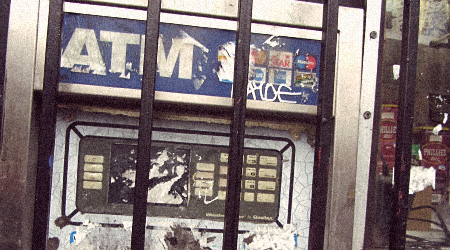How Secure Are ATMs?

Automated teller machines have been in use since the 1960s when they became widely accepted by consumers. The convenience of ATMs allows bank account holders to make withdrawals, deposits, transfer funds and conduct inquiries. Unfortunately, the technology has not evolved significantly over the decades and the same method of sliding a plastic card into a reader and entering a PIN has stayed much the same. Criminals have gotten smarter and use the lack of ATM sophistication to their advantage but there are steps consumers can take to protect themselves.
Location Matters
It is relatively easy for any business who wishes to have an ATM to purchase one and have it installed with little effort. As a result, there are hundreds of thousands of ATMs across the country and millions worldwide. As with walking down a dark alley at night, some ATM locations will be more secure than others. When using an automated teller machine, try picking a location that is well lit, in a public space with medium to heavy foot traffic. A poorly lit ATM in the middle of a parking lot at two in the morning is the perfect setting for a criminal to take your money.
Line of Sight
An automated teller machine allows consumers to have access to their accounts when their bank or credit union is closed. Most ATMs are often outdoors or in open areas and use a screen to display actions and information. Keep this in mind when operating an ATM and think about line of sight and who might be watching your transaction. Try using your body to block the screen view when conducting business. It's not a good thing to casually stand away from the ATM and withdraw hundreds of dollars as anyone could be watching. Also keep in mind that criminals install ATM card skimmers on the machine face to capture card information and PINs as they are entered. If the machine doesn't look right then take your card and go to a different ATM.
Protect Your PIN
While online banking via computer, smart phone or tablet often uses two factor authentication or secure passwords, ATMs still use a single four digit number to access your money. In all honesty, this is a very insecure method of accessing banking information and funds. It does however require direct access to an ATM, a fabricated card with information imprinted onto the magnetic strip and the PIN. Never tell anyone your personal identification number or write it down in a location which is easily accessible to others. If a bank or credit union finds out that money was illicitly drawn from your account due to negligence instead of fraud you may not be compensated.
Save Receipts
Any time an automated teller machine is used it will generate a receipt once the transaction is complete. While most consumers throw the receipts away in the closest garbage can, this is the incorrect thing to do. Any process, either automated or by a human, has the possibility of an error and the receipt is the only proof you have to support your case. Save all ATM receipts and compare them to your monthly bank statements to verify withdrawals, deposits and transfers are for the correct amounts.
Conclusion
Generally speaking, ATMs are very secure if used properly and with common sense. Taking out $200 in the dead of night in a questionable location will always be a bad idea. Letting friends or family use your ATM card and providing them with your PIN is never recommended. And throwing ATM receipts in the garbage immediately following a transaction leaves you vulnerable to mistakes made by the bank. There is a common saying that they "a fool and his money are soon parted". Take this to heart and be smart when using an automated teller machine.







